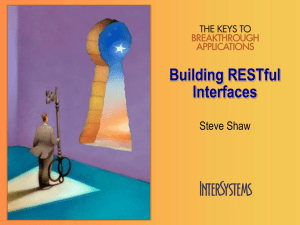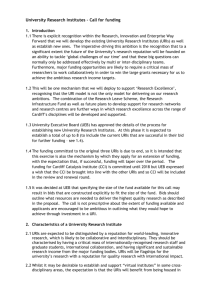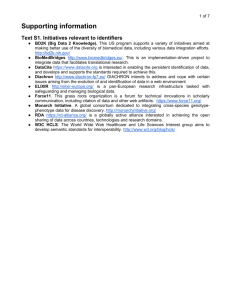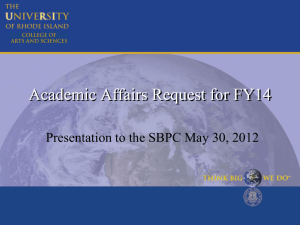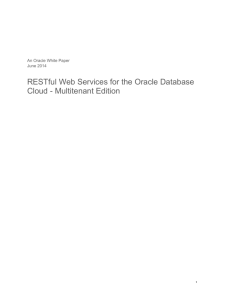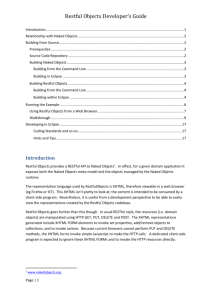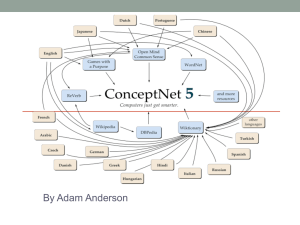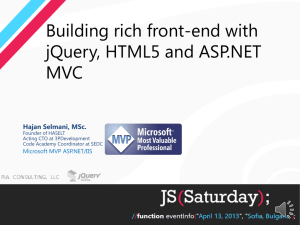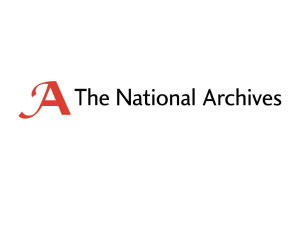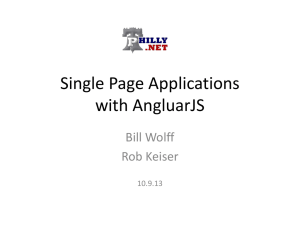RESTful Architecture In Practice
advertisement
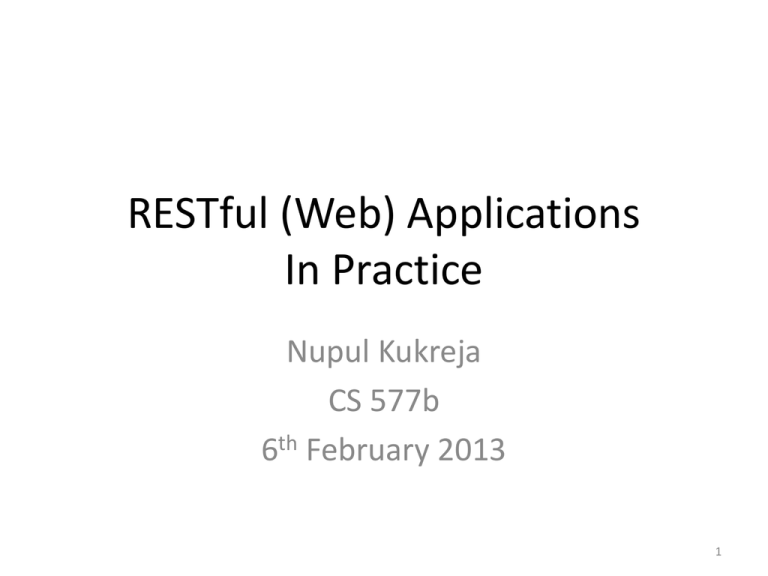
RESTful (Web) Applications
In Practice
Nupul Kukreja
CS 577b
6th February 2013
1
Agenda
• REST – What/Why?
• REST in Practice – How?
– Real life example: Winbook
• Architectural styles commonly encountered
when creating RESTful (web) systems
– Event Based
– MVC (Client/Server)
• Winbook – Behind the scenes
2
REST (REpresentational State Transfer)
• The architectural style of the web
So what %&*@#$ does that even mean??
• REST is a set of design criteria and not the
physical structure (architecture) of the system
• REST is not tied to the ‘Web’ i.e. doesn’t
depend on the mechanics of HTTP
• ‘Web’ applications are the most prevalent –
hence RESTful architectures run off of it
3
Understanding REST
Based on content from chapter #3 of:
RESTful Web Services (O’Reilly)
-Richardson & Ruby
4
Understanding REST – Resources
• Anything that’s important enough to be
referenced as a thing in itself
• Something that can be stored on a computer
and represented as a stream of bits:
– A document (e.g. information about USC)
– Row in DB (e.g. ‘User Profile’)
– Output of executing an algorithm (e.g. 100th Prime
number or Google Search )
5
URIs and Resources
• URI is an ‘address’ of a resource
• A resource must have at least one URI
• No URI Not a resource (i.e. it’s really not on
the web, so to speak )
• URIs should be descriptive (human parseable)
and have structure. For Example:
–
–
–
–
–
http://www.ex.com/software/releases/latest.tar.gz
http://www.ex.com/map/roads/USA/CA/17_mile_drive
http://www.ex.com/search/cs578
http://www.ex.com/sales/2012/Q1
http://www.ex.com/relationships/Alice;Bob
6
URIs and Resources (Cont’d)
• Not so good URIs (everything as query parameters):
– http://www.ex.com?software=VisualParadigm&release=latest
&filetype=tar&method=fetch
– http://www.ex.com?sessionId=1234567890876543212345678765432
34567865432345678876543&itemId=9AXFE5&method=addToCart
• URIs need not have structure/predictability but are
valuable (and easier) for the (human) clients to
navigate through the application
• May have multiple URIs to refer to same resource –
convenient but confusing
• Each URI must refer to a unique resource – although
they may point to the ‘same one’ at some point in time
(Ex.: …/latest.tar.gz and …/v1.5.6.tar.gz)
7
Understanding REST - Addressability
• An application is addressable if it exposes
interesting aspects of its data set as resources
• An addressable application exposes a URI for
every piece of information it might conceivably
serve (usually infinitely many )
• Most important from end-user perspective
• Addressability allows one to bookmark URIs or
embed them in presentations/books etc. Ex.:
– google.com/search?q=CS577+USC
– Instead of
• Go to www.google.com
• Enter ‘CS577 USC’ (without quotes in search box)
• Click ‘Search’ or hit the ‘Enter key’
8
REST Principle #1
The key abstraction of information is a resource,
named by a URI. Any information that can be
named can be a resource
9
Understanding REST - Statelessness
• Every HTTP request happens in complete
isolation
– Server NEVER relies on information from prior
requests
– There is no specific ‘ordering’ of client requests
(i.e. page 2 may be requested before page 1)
– If the server restarts a client can resend the
request and continue from it left off
• Possible states of a server are also resources
and should be given their own URIs!
10
REST Principle #2
All interactions are context-free: each interaction
contains all of the information necessary to
understand the request, independent of any
requests that may have preceded it.
11
Understanding REST - Representations
• Resources are NOT data – they are an
abstraction of how the information/data is
split up for presentation/consumption
• The web server must respond to a request by
sending a series of bytes in a specific file
format, in a specific language – i.e. a
representation of the resource
– Formats: XML/JSON, HTML, PDF, PPT, DOCX...
– Languages: English, Spanish, Hindi, Portuguese…
12
Which Representation to Request?
• Style 1: Distinct URI for each representation:
– ex.com/press-release/2012-11.en (English)
– ex.com/press-release/2012.11.fr (French)
– …and so on
• Style 2: Content Negotiation
– Expose Platonic form URI:
• ex.com/press-release/2012-11
– Client sets specific HTTP request headers to signal
what representations it’s willing to accept
• Accept: Acceptable file formats
• Accept-Language: Preferred language
13
REST Principle #3
The representation of a resource is a sequence of
bytes, plus representation metadata to describe
those bytes. The particular form of the
representation can be negotiated between REST
components
14
Understanding REST – Uniform Interface
• HTTP Provides 4 basic methods for CRUD (create,
read, update, delete) operations:
– GET: Retrieve representation of resource
– PUT: Update/modify existing resource (or create a
new resource)
– POST: Create a new resource
– DELETE: Delete an existing resource
• Another 2 less commonly used methods:
– HEAD: Fetch meta-data of representation only (i.e. a
metadata representation)
– OPTIONS: Check which HTTP methods a particular
resource supports
15
HTTP Request/Response
Method
GET
DELETE
Request EntityBody/Representation
Response EntityBody/Representation
(Usually) Empty
Server returns representation of
Representation/entity-body sent by resource in HTTP Response
client
(Usually) Empty
Server may return entity body
Representation/entity-body sent by with status message or nothing at
client
all
PUT
Client’s proposed representation of Server may respond back with
resource in entity-body
status message or with copy of
representation or nothing at all
POST
Client’s proposed representation of Server may respond back with
resource in entity-body
status message or with copy of
representation or nothing at all
16
PUT vs. POST
• POST
– Commonly used for creating subordinate resources
existing in relation to some ‘parent’ resource
• Parent: /weblogs/myweblog
• Children: /weblogs/myweblog/entries/1
• Parent: Table in DB; Child: Row in Table
• PUT
– Usually used for modifying existing resources
– May also be used for creating resources
• PUT vs. POST (for creation)
– PUT: Client is in charge of deciding which URI resource
should have
– POST: Server is in charge of deciding which URI resource
should have
17
PUT vs. POST (Cont’d)
• What in case of partial updates or appending
new data? PUT or POST?
– PUT states: Send completely new representation
overwriting current one
– POST states: Create new resource
• In practice:
– PUT for partial updates works fine. No
evidence/claim for ‘why’ it can’t (or shouldn’t) be
used as such (personal preference)
– POST may also be used and some purists prefer
this
18
REST Principle #4
Components perform only a small set of well-defined
methods on a resource producing a representation to
capture the current or intended state of that resource
and transfer that representation between components.
These methods are global to the specific architectural
instantiation of REST; for instance, all resources exposed
via HTTP are expected to support each operation
identically
19
Understanding REST – Safety & Idempotence
• When correctly used GET and HEAD requests are safe
and GET, HEAD, PUT, DELETE are idempotent. POST is
neither safe nor idempotent
• Safety: The request doesn’t change server state i.e. no
side effects no changing state of resource
– Making 10 requests is same as making one or none at all
• Idempotence: Executing the same operation multiple
times is the same as executing it once
– Deleting an already DELETE-ed resource is still deleted
– Updating an already updated resource with PUT has no
effect
20
Safety and Idempotence
• Why do they matter?
• Lets a client make reliable HTTP requests over
an unreliable connection
• If no response then just reissue the request
• Some common mistakes/misuses:
– GET https://some.api.com/item/delete
– (Overloaded )POST https://some.api.com/item
• Entity-body: Method=fetch
• Or setting different query parameters
• Basically using POST for everything
21
REST Principle #5
Idempotent operations and representation
metadata are encouraged in support of caching
and representation reuse.
22
REST Principle #6
The presence of intermediaries is promoted. Filtering or
redirection intermediaries may also use both the
metadata and the representations within requests or
responses to augment, restrict, or modify requests and
responses in a manner that is transparent to both the
user agent and the origin server.
23
Steps to a RESTful Architecture
Read the Requirements and turn them into resources
1. Figure out the data set
2. Split the data set into resources
For each kind of resource:
3. Name resources with URIs
4. Expose a subset of uniform interface
5. Design representation(s) accepted from client (Form-data,
JSON, XML to be sent to server)
6. Design representation(s) served to client (file-format,
language and/or (which) status message to be sent)
7. Consider typical course of events: sunny-day scenarios
8. Consider alternative/error conditions: rainy-day scenarios
24
HTTP Status/Response Codes
• HTTP is built in with a set of status codes for
various types of scenarios:
– 2xx Success (200 OK, 201 Created…)
– 3xx Redirection (303 See other)
– 4xx Client error (404 Not Found)
– 5xx Server error (500 Internal Server Errror)
• Leverage existing status codes to handle
sunny/rainy-day scenarios in your application!
25
Points to Note
• Authentication/Authorization data sent with every
request
• Sessions are NOT RESTful (i.e. sessions = state)
• Cookies, if used appropriately (for storing client state)
are RESTful
• 100% RESTful architecture is not practical and not
valuable either
• Need to be unRESTful at times (Eg.: Login/Logout)
– These are actions and not a resource per se
– Usually POST requests sent to some URI for logging in/out
– Advantages: Gives login page, provides ability of “Forgot
your password” type functionalities etc.
– Benefits of UnRESTful-ness outweigh adherence to style
• Some server frameworks only support GET/POST
forcing one to overload POST requests for PUT/DELETE
26
Benefits of RESTful Design
• Simpler and intuitive design – easier navigability
• Server doesn’t have to worry about client timeout
• Clients can easily survive a server restart (state controlled
by client instead of server)
• Easy distribution – since requests are independent they can
be handled by different servers
• Scalability: As simple as connecting more servers
• Stateless applications are easier to cache – applications can
decide which response to cache without worrying about
‘state’ of a previous request
• Bookmark-able URIs/Application States
• HTTP is stateless by default – developing applications with
it gets above benefits (unless you wish to break them on
purpose )
27
RESTful Architecture Example
Winbook
28
Winbook
• RESTful design – uses Restlet framework (Java)
for implementing RESTful design
• Javascript (i.e. xmlhttpRequest (ajax)) for
sending GET, PUT, DELETE and POST requests
29
Winbook: Resources (Cont’d)
• Project Resource (A single team project)
• Wall Resource (list of ‘posts’)
• Category Resource (list of color-coded labels
for categorizing win conditions)
• User Account
• (User) Membership
• Agreements – individual user agreements (i.e.
similar to individual ‘Likes’ on Facebook)
30
Winbook: Resource URIs & Methods
Resource
URI (structure)
List of Projects
/projects
Single Project
/projects/{project}
Project Wall
/projects/{project}/{wall}
Win Condition
/projects/{project}/{wall}/WinConditions/{id}
Issue
/projects/{project}/{wall}/WinConditions/{id}/Issues/{id}
Option
…/WinConditions/{id}/Issues/{id}/Options/{id}
List of Categories
/projects/{project}/{wall}/Categories
Category
/projects/{project}/{wall}/Categories/{id}
{…} = variable value; changeable by user/application to refer to specific resource
31
Resource
URI
Method (Accepted/Client
Representations |Server Response)
List of Projects
/projects
GET (“html”)
Single Project
/projects/{project}
GET(“html”); PUT(“json”|”json”)
Project Wall
/projects/{project}/{wall}
GET(“html”); PUT(“json”|”json”)
List of WCs
/projects/…/WinConditions
GET(“html”);
Win Condition
/projects/{project}/{wall}/
WinConditions/{id}
PUT(“form”|Status);
POST(“form”|”json”); DELETE(.|Status)
Issue
…/WinConditions/{id}/
Issues/{id}
PUT(“form”|Status);
POST(“form”|”json”); DELETE(.|Status)
Option
…/WinConditions/{id}/
Issues/{id}/Options/{id}
PUT(“form”|Status);
POST(“form”|”json”); DELETE(.|Status)
List of Categories /projects/{project}/{wall}/
Categories
POST(“form”|”String”)
Category
PUT(“form”|Status); DELETE(.|Status)
/projects/{project}/{wall}/
Categories/{id}
For each of the server responses an HTTP Status code is also sent with representation
Item fetches children internally; Children not explicitly exposed by GET
32
33
Show Me The Code!
Winbook is Based on Restlet –
A Restful framework for Java
34
Setting-up URI Routing
35
Create ‘Resource Interfaces’
36
37
Winbook
Behind the Scenes
http://pattaya.usc.edu:8080/Winbook
38
RESTful Frameworks
• Almost all frameworks allow you to:
1. Specify URI Patterns for routing HTTP requests
2. Set allowable HTTP Methods on resources
3. Return various different representations (JSON,
XML, HTML most popular)
4. Support content negotiation
5. Implement/follow the studied REST principles
• Restlet is ONE of the many frameworks…
39
List of REST Frameworks
•
•
•
•
•
•
•
Rails Framework for Ruby (Ruby on Rails)
Django (Python)
Jersey /JAX-RS (Java)
Restlet (Java)
Sinatra (Ruby)
Express.js (JavaScript/Node.js)
…and many others: View complete list at:
http://code.google.com/p/implementingrest/wiki/RESTFrameworks
40
Architectural Styles Encountered
With REST
REST isn’t alone
41
Model-View-Controller (MVC)
• Most commonly employed style with
frameworks:
– Model: Classes responsible for talking to the DB and
fetching/populating objects for the application
– Controller: Acts as URI Router i.e. routes calls to
specific resources and invokes actions based on the
corresponding HTTP Method
– View: Usually the resource itself that returns the
content/representation as requested by the client
• May/may-not be true MVC but parts of
application usually split as such – leading to clean
code organization/separation of concerns
42
Client-Side MVC
• JS heavy pages lead to spaghetti code
• Frameworks like Backbone.js, Ember.js implement MVC
paradigm on web page itself making code easier to
manage/maintain
– Models: Data that is fetched/saved from/to the server
– Views: HTML elements that display the data and change if
the data is updated
– Controller: Intercepts user-events and sends appropriate
messages to model/views
• JS Models communicate with server (controller) to
update themselves
• Client-side MVC becoming very popular and critical for
‘front-heavy’/smart-client web-apps based on Ajax
43
Event-Based Architectures
• Exclusively client-side:
– Required for communicating between various parts of the
JS application/elements
– Based on the Observer pattern – an event bus is used for
sending/receiving messages across components
• Exclusively server-side:
– For implementing asynchronous communications between
different process (e.g.: sending email after a particular
action)
– Communicating with other processes on the network via a
Message oriented Middleware (MoM) (e.g.: RabbitMQ,
WebSphereMQ etc.)
– Communicating with client-side apps – using Node.js or
Pub/Sub web services like PubNub.com or Pusher.com
44
Conclusion
• Just REST isn’t enough
• 100% REST isn’t the goal either
• Various architectural styles work together in
tandem for creating distributed web-based
systems
• MVC on client-side is gaining high momentum
• Event-based communication exceedingly
important for near-real-time/asynchronous
applications (reason for Node.js popularity)
• You can learn the REST by reading a few books
and designing/implementing a few systems
45
